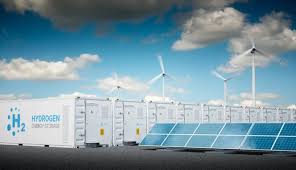Solar hydrogen panel- An powerful source of Renewable energy -23
Solar hydrogen panel
Solar hydrogen panels hold tremendous promise for the development of a sustainable green hydrogen economy. Unlike the conventional method of hydrogen production through steam reforming of natural gas, which results in the release of carbon dioxide, solar hydrogen panels offer an environmentally friendly alternative.
As of 2015, the global hydrogen market was predominantly dominated by steam methane reforming, which had driven hydrogen prices down to as low as $1 per kilogram of hydrogen (H2).
However, the tide is shifting towards cleaner and more sustainable hydrogen production methods. In 2019, the International Energy Agency (IEA) reported that the electrolysis of water, a green approach to generating hydrogen, accounted for less than 0.1% of the world’s hydrogen production.

This low percentage underscores the immense potential for growth in the adoption of electrolysis, particularly as renewable energy sources like solar power become more prevalent and cost-effective.
Follow Our Digiknowledge.co.in Page for Latest update about Bikes, Cars, Sports, Government Policy and many more.
Working of Solar hydrogen panels
Solar hydrogen panels harness the power of the sun to split water molecules into hydrogen and oxygen through a process called electrolysis. This method not only avoids carbon emissions entirely but also offers a scalable and renewable means of producing hydrogen.
As the world increasingly recognizes the importance of reducing greenhouse gas emissions and transitioning to sustainable energy sources, solar hydrogen panels are poised to play a pivotal role in driving the green hydrogen revolution forward.
The shift towards these cleaner technologies heralds a brighter and more environmentally conscious future for hydrogen production and the broader energy landscape.
Design of solar hydrogen panels
Within the innovative design of solar hydrogen panels, the crucial hydrogen and oxygen evolution reactions occur in the gas phase, each taking place within their respective cathode and anode compartments. These compartments are intelligently separated by a specialized membrane.

This approach not only promotes efficiency but also sustainability, as it reduces the reliance on rare and costly materials. By leveraging the power of anion exchange membranes, solar hydrogen panels are leading the way in making hydrogen production more accessible, cost-effective, and environmentally friendly.
Solar hydrogen panels advantages
- Clean and Renewable Energy: Solar hydrogen panels utilize sunlight, an abundant and renewable energy source, to produce hydrogen. This process is entirely clean, emitting no greenhouse gases or pollutants, contributing to a reduction in carbon emissions and environmental preservation.
- High Efficiency: These panels can achieve high energy conversion efficiencies by directly harnessing sunlight to split water into hydrogen and oxygen. This efficiency can rival or even surpass traditional solar cells combined with separate electrolysis systems.
- Energy Storage: Hydrogen generated by solar hydrogen panels can be stored and used as an energy carrier. This makes it a valuable solution for intermittent renewable energy sources like solar and wind, as excess energy can be stored as hydrogen and used when needed.
- Grid Stabilization: The stored hydrogen can be used for grid stabilization and balancing, helping to address the variability of renewable energy sources and enhancing the reliability of the energy grid.
- Scalability: Solar hydrogen panels are scalable, making them suitable for various applications, from small-scale residential setups to large industrial systems, depending on energy needs.
- Reduced Dependency on Fossil Fuels: By providing a clean source of hydrogen, these panels reduce our reliance on fossil fuels for hydrogen production, which is currently a major source of greenhouse gas emissions.
- Local Production: Solar hydrogen panels can be deployed near the point of use, reducing the need for long-distance transportation of hydrogen and minimizing energy losses associated with transportation.
- Compatibility with Existing Infrastructure: Hydrogen produced by solar hydrogen panels can be used in existing hydrogen infrastructure, such as fuel cell vehicles and industrial processes.
- Environmental Benefits: Producing hydrogen through solar hydrogen panels avoids the environmental impacts associated with traditional hydrogen production methods, such as steam methane reforming.
- Research and Innovation: Continued development and research in this field are driving advancements in materials and technology, which can lead to further efficiency improvements and cost reductions.

Difference between Solar Panels Solar Hydrogen Panels–
- Solar Panels (Photovoltaic Panels):
- Function: Solar panels, also known as photovoltaic panels or PV panels, primarily generate electricity by converting sunlight directly into electrical energy.
- Energy Output: They produce electricity in the form of direct current (DC), which can be used to power electrical devices or stored in batteries.
- Applications: Solar panels are commonly used for residential, commercial, and industrial applications to generate electricity for buildings, homes, and various electrical appliances.
- Energy Storage: Excess electricity can be stored in batteries for later use or can be fed back into the grid (net metering).
- Environmental Impact: Solar panels reduce carbon emissions by generating clean electricity, but they do not directly produce hydrogen.
2 .Solar Hydrogen Panels (Photocatalytic Water Splitting Panels):
- Function: Solar hydrogen panels use sunlight to drive a chemical reaction called photocatalytic water splitting, which produces hydrogen gas (H2) and oxygen (O2) from water vapor.
- Energy Output: They generate hydrogen gas, which can be stored and used as an energy carrier or fuel for various applications, including fuel cells.
- Applications: Solar hydrogen panels are specifically designed for hydrogen production, making them suitable for industries, transportation (fuel cell vehicles), and energy storage.
- Energy Storage: Hydrogen produced can be stored and used when needed, making it a valuable energy storage medium.
- Environmental Impact: Solar hydrogen panels contribute to clean energy production by producing a clean and renewable source of hydrogen, which can replace hydrogen produced from fossil fuels.
I
How much energy is in 1kg of hydrogen?
When used as part of a fuel cell, 1 kg of hydrogen can produce 33 kWh of electrical energy. I
What is the price of H2 cost per kg?
Hydrogen from renewable energy nearly costs about $5 – $7 per kilogram.
Will Hydrogen catch fire?
Hydrogen used in the fuel cells is a very flammable gas and can cause fires and explosions if it is not handled properly





When I originally commented I clicked the -Notify me when new comments are added- checkbox and now every time a comment is added I get 4 emails with the identical comment. Is there any method you may take away me from that service? Thanks!
Thank you! I’m glad you found the information helpful. If you have any specific questions or need further clarification on any of the points, feel free to ask. I’m here to help!
Pingback: Transparent Solar Panels:Changing Technology 24 - Digiknowledge
Thank you so much for your kind words and support! I’m delighted to hear that you find the website and posts helpful. If you have any questions, suggestions, or topics you’d like to see covered, please feel free to let me know. Best regards to you as well!
Pingback: Ultracapacitor For Fast Charging Battery 24 - Digiknowledge
Thank you so much for your kind words and support! I’m delighted to hear that you find the website and posts helpful. If you have any questions, suggestions, or topics you’d like to see covered, please feel free to let me know. Best regards to you as well!